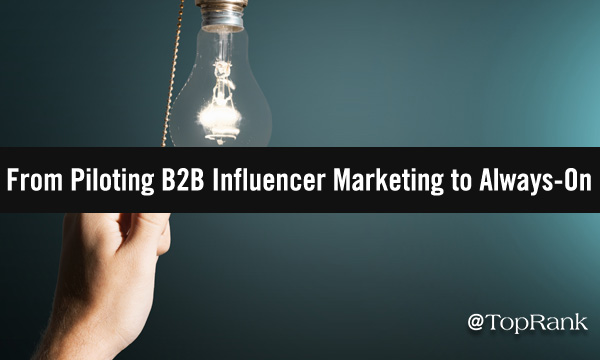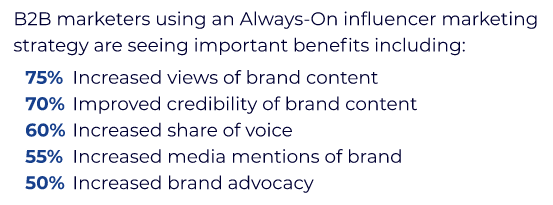
It sure is a good thing that the internet turns off at 10:00 PM every night, and doesn’t flip back on until 8:00 in the morning. And thankfully, business buyers completely tune out after they finish work, which is always at 5 o’clock sharp in this world of reliable and universally consistent routine.
Marketers and brands would really have their hands full if these things weren’t true.
Wait, what’s that? None of them are remotely true?
Welcome to the World of Always-On
There is no off-switch. The internet is open for business 24 hours a day. Buyers and decision makers are engaging with content in unpredictable patterns, thrown further askew by the pandemic-driven disruption of workday archetypes. An increasingly lengthy and complex buyer’s journey challenges B2B marketing strategies to be more versatile, agile, and perpetually present than ever before.
“There is no off-switch. The internet is open for business 24 hours a day. Buyers and decision makers are engaging with content in unpredictable patterns.” @NickNelsonMN #AlwaysOn #B2Bmarketing Click To Tweet
Earlier this month, Howard J. Sewell wrote at Business 2 Community about marketing success and the accident of timing.
“For more companies than not, marketing success is rarely about convincing a given individual, on a given day, to buy what it is you’re selling,” he argues. “Rather, it’s a question of being the company that the buyer finds, or thinks of first, when the relevant need occurs.”
This essentially makes the case for adopting always-on marketing programs, which are gaining traction as more organizations see the value. It’s a convention that can apply to many different elements of a strategy, including (and especially) influencer marketing.
Today we’ll explore taking the step from pilot B2B influencer marketing program to always-on success — why and how?
Taking B2B Influencer Marketing from Pilot to Autopilot
Running a pilot program is a great way to get a feel for influencer marketing and validate it as a smart tactic for your organization. Earlier this year I shared tips for jumpstarting a pilot B2B influencer marketing program in five steps, which included:
- Get buy-in throughout the organization
- Compile a list of influencers who align with your brand
- Start priming influencer relationships
- Integrate B2B influencer marketing into your strategy
- Co-create a piece of content with one or more influencers
The key here is not to treat influencer engagements as one-off, transactional encounters. As TopRank Marketing CEO Lee Odden put it during an interview for the Social Media Marketing Live Streaming Show over the summer, “If you only have one interaction with an influencer and then you don’t ever see that person until the next time you need them, that leaves the influencer feeling very transactional, and not very special.”
Running a pilot program doesn’t need to entail a long-term commitment to influencer marketing in your strategy, but it should always be built on a long-term, relationship-building mindset.
This sets you up to take the next step: from pilot to autopilot, where your always-on influencer program becomes a self-sustaining community of genuine brand advocacy and affinity. That’s not to say it’ll become completely hands-off — maintaining and nurturing influencer relationships takes work, as do the collaborative efforts with these influencers that drive business results — but once you’ve laid proper groundwork and set a clear vision, much of the heavy lifting is done.
Lee makes this point in explaining why always-on influence costs less and provides better ROI. Some things he recommends keeping in mind:
- Pay-to-play doesn’t always pay off: Organic relationship-building can take a little more time and effort up front, but tends to be far less expensive than one-off, paid influencer campaigns, with much greater all-around value.
- Old friends know the brand ropes: Deeper ongoing engagements with influencers leads to better mutual understanding of needs and guidelines, with less hand-holding required.
- Return on relationships: Building authentic relationships with influential experts in your industry yields word-of-mouth and proactive advocacy benefits that money can’t buy.
- Repurpose with a purpose: Always-on programs bring new efficiencies in terms of repurposing and refreshing co-created content in ways that support the brand, influencer, and audience.
- Advocacy at scale: Developing and strengthening relationships over time leads to compounding benefits, as trust grows and new contacts enter the fold.
When considering these advantages, it comes as no real shock that — according to the 2020 State of B2B Influencer Marketing Report — only 5% marketers who do periodic campaigns are very successful vs. 60% of marketers who implement always-on influencer marketing programs. That is a sizable chasm.
“Being ‘always-on’ has allowed our team to build meaningful relationships with influencers,” says Garnor Morantes, Group Marketing Manager for LinkedIn (a TopRank Marketing client) in the report. “This approach means that the relationship ceases to be ‘transactional’ (what can you do for us) when we’re in a state of ongoing activity. Because of this foundation, we are in a situation where, when urgency strikes, we’ve been able to immediately activate influencers, whether it be for private, direct, unfiltered feedback and consult, or for external, public-facing advocacy and amplification.”
““Being ‘always-on’ has allowed our team to build meaningful relationships with influencers.” Garnor Morantes of @LinkedIn #InfluencerMarketing #AlwaysOn Click To Tweet
That’s the kind of marketing engine built for our modern-day environment, where buyers and decision makers are essentially active and consuming content round-the-clock, seven days a week. An always-on influencer strategy allows brands to be reactive, nimble, and responsive to change. You can learn more about LinkedIn’s successful program in our case study.

Take the Next Step with Always-On Influence
The good news is that a properly executed pilot influencer marketing program — one focused on relationship-building and brand synergy — helps facilitate the transition to an always-on program that can become a pillar of your marketing strategy. At TopRank Marketing, we’re happy to help out with whichever stage of the journey you’re in.
Check out the 2020 State of B2B Influencer Marketing Report to learn more about always-on influence, why it makes sense, and how to make it work. Reach out to us if you’re ready to get rolling.

Comments are Closed